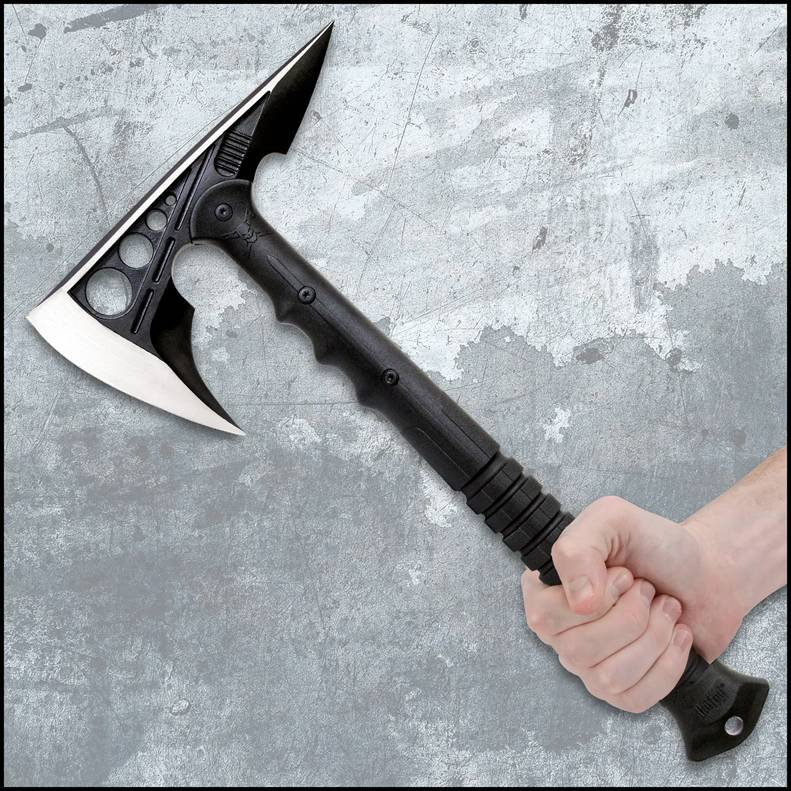The Basic Uses for a Tactical Axe: A Complete Guide for Beginners


The tactical axe is one of the most versatile tools in the world of survival gear, self-defense, and utility equipment. Far from being just a modernized hatchet, the tactical axe combines ancient heritage with contemporary functionality. Whether you're a camper, a prepper, a hiker, a survivalist, or someone interested in bushcraft and home preparedness, learning how to properly use a tactical axe can greatly improve your effectiveness in the outdoors and your confidence in emergency scenarios. In this guide, we’ll explore the basic uses of a tactical axe, its design features, and how it compares to other tools. We’ll also look at common scenarios where a tactical axe becomes invaluable and provide tips for proper care and safety.
What Is a Tactical Axe?
A tactical axe (also referred to as a tactical tomahawk or combat axe) is a multi-functional tool designed for durability, compactness, and practical use in a variety of situations. Unlike a traditional woodcutting axe, tactical axes are typically lighter, shorter, and optimized for more than just chopping wood—they are often used for breaching, self-defense, and emergency rescue.
Most tactical axes are made with high-carbon steel or stainless steel heads and feature ergonomic, non-slip handles made of materials like fiberglass, polymer, or reinforced nylon. Many modern designs also include features like pry bars, hammer heads, pick spikes, or even wrenches and hex sockets built into the axe head.
Chopping and Splitting Wood
One of the most basic and essential functions of any axe, including a tactical axe, is wood processing. In camping or survival scenarios, you can use a tactical axe to:
- Chop firewood from fallen limbs
- Split logs for kindling
- Cut small branches or saplings for shelter building
- Baton wood (striking the axe with a baton or mallet to split through tougher wood)
Self-Defense and Combat
Tactical axes have deep roots in history as weapons. From Viking battle axes to Native American tomahawks, axes have been used for close-quarters combat for centuries. Today, many tactical axes are designed with combat in mind:
- Bladed edge: Can be used for slashing or chopping
- Spike or hammer opposite the blade: Adds utility for puncturing or crushing
- Ergonomic grip: Improves retention and control in fast movements
Breaching and Entry
In law enforcement and military contexts, tactical axes are often used to breach doors, smash windows, or pry open containers. This makes them extremely useful for:
- Emergency rescue situations (e.g., breaking a car window to pull someone out)
- Disaster preparedness (e.g., gaining access through a jammed door)
- Urban survival (e.g., navigating through debris or locked buildings)
Throwing (Recreational or Tactical Use)
Some tactical axes—especially tomahawks—are well-balanced and lightweight enough to be used for throwing. Axe throwing is now a popular recreational sport, but in survival or combat training, throwing a tomahawk was historically a viable tactic to disarm or wound an opponent.
While throwing a tactical axe is more niche and skill-based than practical, it is a legitimate use for some models with the right weight balance.
Cutting and Carving
Although it’s bulkier than a knife, a tactical axe can also handle many precision cutting tasks, especially in the wilderness:
- Shaving wood for feather sticks or tinder
- Crafting tent pegs or bushcraft tools
- Clearing vines or brush
- Trimming meat or fish in survival settings
Hammering and Prying
Many tactical axes include a flat poll or dedicated hammer side opposite the blade, making them excellent for:
- Driving tent stakes into the ground
- Smashing through drywall, concrete, or obstacles
- Breaking glass or ice
- Prying open boxes, lids, or doors using a hooked head
Hiking and Trail Clearing
Hikers and backpackers may use a tactical axe to:
- Clear overgrown trails or saplings
- Remove fallen branches or brush
- Create walking sticks or trail markers
- Lightly dig or remove obstacles in the ground
Outdoor Cooking and Fire Preparation
Beyond chopping wood, a tactical axe can help with:
- Digging a fire pit or trench
- Creating spark with a ferro rod (using the spine)
- Cutting and shaping cooking sticks
- Opening cans (in some axe head designs)
Tactical Axe Maintenance and Care
To get the most from your tactical axe, proper maintenance is essential:
- Sharpen the blade regularly using a sharpening stone or file
- Clean after use, especially after exposure to moisture, sap, or blood
- Oil the blade to prevent rust
- Inspect the handle and head for wear, cracks, or looseness
- Store in a dry place, ideally in a sheath or cover
Safety Tips
- Always wear gloves and eye protection when using a tactical axe
- Never swing near others or in enclosed areas
- Ensure a firm grip and a clear cutting zone
- Keep it sheathed when not in use
- Practice before relying on it in a real-world scenario
Grab Your Tactical Axe Today
A tactical axe is a serious multipurpose tool that serves as an extension of your preparedness, strength, and adaptability. From camping and trail clearing to home emergencies and self-defense, it delivers unmatched value in a compact, reliable form that is also easy to store on the go.
Whether you’re a seasoned outdoorsman or a first-time buyer building your emergency kit, understanding the basic uses of a tactical axe is your first step toward mastering it. Choose wisely, train well, and your tactical axe may become one of the most valuable tools you ever own.
Whether you’re a seasoned outdoorsman or a first-time buyer building your emergency kit, understanding the basic uses of a tactical axe is your first step toward mastering it. Choose wisely, train well, and your tactical axe may become one of the most valuable tools you ever own.